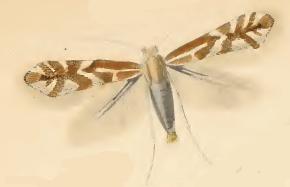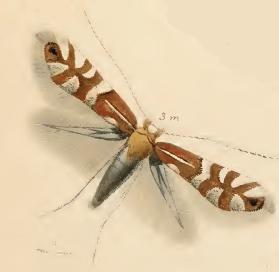
Junonia hierta, the yellow pansy, is a species of nymphalid butterfly found in the Palaeotropics. It is usually seen in open scrub and grassland habitats.

Melanitis phedima, the dark evening brown, is a species of butterfly found flying at dusk. The flight of this species is erratic. They are found in south and southeast Asia.

Vindula erota, the common cruiser, is a species of nymphalid butterfly found in forested areas of tropical South Asia and Southeast Asia.

Lozotaenia forsterana is a moth of the family Tortricidae. It is found in Europe and across the Palearctic.

Epinotia ramella is a moth of the family Tortricidae. It is found in Europe, China, Japan, Russia and Kazakhstan.

Gypsonoma aceriana, the poplar shoot-borer, is a moth of the family Tortricidae. It is found from Europe to Russia, eastern Turkey and Iraq. It is also present in North Africa.
Merimnetria epermeniella is a moth of the family Gelechiidae. It was first described by Lord Walsingham in 1907. It is endemic to the Hawaiian island of Kauai.

Phyllonorycter viminetorum is a moth of the family Gracillariidae. It is found from Latvia to the Pyrenees and Italy and from Ireland to Ukraine.

Phyllonorycter ulmifoliella is a moth of the family Gracillariidae. It is found in all of Europe, east to Russia and Japan.

Elachista poae is a moth of the family Elachistidae found in Europe.

Scrobipalpa atriplicella, the goosefoot groundling moth, is a moth of the family Gelechiidae. It is found from most of Europe throughout Asia to Kamchatka and Japan. It is an introduced species in North America.
Garrha phoenopis is a moth in the family Oecophoridae. It was described by Turner in 1916. It is found in Australia, where it has been recorded from Queensland and the Northern Territory.
Hemiarcha bleptodes is a moth in the family Gelechiidae. It was described by Turner in 1919. It is found in Australia, where it has been recorded from Queensland and New South Wales.
Anacampsis lapidella is a moth of the family Gelechiidae. It was described by Thomas de Grey in 1897. It is found in the West Indies (Grenada).
Palumbina glaucitis is a moth of the family Gelechiidae. It was described by Edward Meyrick in 1907. It is found in southern India and Sri Lanka.

Sceptea decedens is a moth in the family Autostichidae. It was described by Walsingham in 1911. It is found in Mexico (Tabasco).
Antaeotricha generatrix is a moth of the family Depressariidae. It is found in Brazil.
Timyra phorcis is a moth in the family Lecithoceridae. It was described by Edward Meyrick in 1908. It is found in Sri Lanka.
Crocanthes pancala is a moth in the family Lecithoceridae. It was described by Turner in 1919. It is found in Australia, where it has been recorded from Queensland.
Muna zostera is a moth in the family Depressariidae, and the only species in the genus Muna. Both the genus and species were described by John Frederick Gates Clarke in 1978. It is found in Chile.








